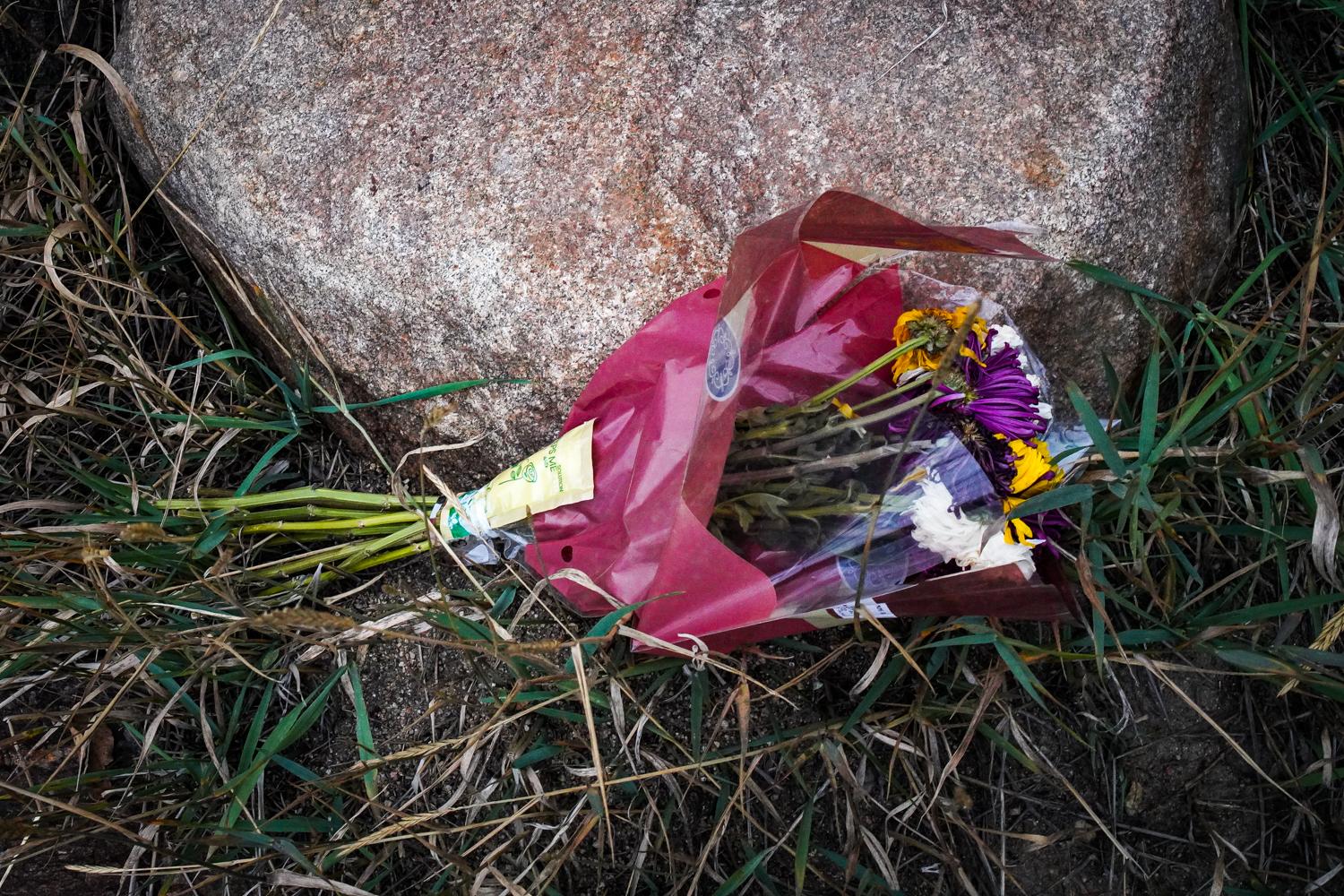
You’ve probably wondered what your dog or cat is thinking. Perhaps you’ve even considered the thoughts of wild animals and those in zoos. How about the feelings of the cows, chickens and pigs that eventually end up on our dinner plates? University of Colorado bioethicist Jessica Pierce and CU professor emeritus and animal behaviorist Marc Bekoff say science shows that animals have rich inner lives, but their treatment by humans doesn't reflect that. Their new book is "The Animals' Agenda: Freedom, Compassion, and Coexistence in the Human Age."
Pierce and Bekoff spoke with Colorado Matters host Andrea Dukakis.
Read an Excerpt:
There comes a time when one must take a position that is neither safe nor politic nor popular, but he must take it because conscience tells him it is right. News headlines these days often center on animals. Stories seem increasingly to be of two types. The first involves reporting on what might be characterized as “the inner lives of animals.” Scientists regularly publish new findings on animal cognition or emotion, and these quickly make their way into the popular press. Here is a sampling of some recent headlines:
The other type of news story focuses on individual animals or a particular group of animals who have been wronged by humans in some significant way. These stories often create a social media frenzy, generating both moral outrage and soul-searching. In particular, these stories highlight instances in which the freedom of an animal has been profoundly violated by humans. Some of these recent hot-button stories include the killing of an African lion named Cecil by an American dentist wanting a trophy head; the killing of a mother grizzly bear named Blaze, who attacked a hiker in Yellowstone National Park; the case of a male polar bear named Andy who was suffocating and starving because of an overly tight radio collar placed around his neck by a researcher; the “euthanizing” and public dissection of a giraffe named Marius at the Copenhagen Zoo because he was not good breeding stock; the ongoing legal battle to assign legal personhood to two research chimpanzees, Leo and Hercules; the exposure of SeaWorld for cruel treatment of orcas, inspired by the tragic story of Tilikum and the documentary Blackfish; and the killing of a gorilla named Harambe at the Cincinnati Zoo, after a small boy fell into the animal’s enclosure. The fact that these events have created such a stir suggests that we are at a tipping point. People who have never really been active in defense of animals are outraged by the senseless violation of these animals’ lives and freedom. The growing awareness of animal cognition and emotion has enabled a shift in perspective. People are sick and tired of all the abuse. Animals are sick and tired of it, too. Yet although we prize our freedom above all else, we routinely deny freedom to nonhuman animals (hereafter, animals) with whom we share our planet. We imprison and enslave animals, we exploit them for their labor and their skin and bodies, we restrict what they can do and with whom they can interact. We don’t let them choose their family or friends, we decide for them when and if and with whom they mate and bear offspring, and often take their children away at birth. We control their movements, their behaviors, their social interactions, while bending them to our will or to our self-serving economic agenda. The justification, if any is given, is that they are lesser creatures, they are not like us, and by implication they are neither as valuable nor as good as we are. We insist that as creatures vastly different from us, they experience the world differently than we do and value different things. But, in fact, they are like us in many ways; indeed, our basic physical and psychological needs are pretty much the same. Like us, they want and need food, water, air, sleep. They need shelter and safety from physical and psychological threats, and an environment they can control. And like us, they have what might be called higher-order needs, such as the need to exercise control over their lives, make choices, do meaningful work, form meaningful relationships with others, and engage in forms of play and creativity. Some measure of freedom is fundamental to satisfying these higher-order needs, and provides a necessary substrate for individuals to thrive and to look forward to a new day. Freedom is the key to many aspects of animal well-being. And lack of freedom is at the root of many of the miseries we intentionally and unintentionally inflict on animals under our “care”—whether they suffer from physical or social isolation, or from being unable to move freely about their world and engage the various senses and capacities for which they are so exquisitely evolved. To do better in our responsibilities toward animals, we must do what we can to make their freedoms the fundamental needs we promote and protect, even when it means giving those needs priority over some of our own wants. The Five Freedoms Many people who have taken an interest in issues of animal protection are familiar with the Five Freedoms. The Five Freedoms originated in the early 1960s in an eighty-five-page British government study, Report of the Technical Committee to Enquire into the Welfare of Animals Kept Under Intensive Livestock Husbandry Systems. This document, informally known as the Brambell Report, was a response to public outcry over the abusive treatment of animals within agricultural settings. Ruth Harrison’s 1964 book Animal Machines brought readers inside the walls of the newly developing industrialized farming systems in the United Kingdom, what we have come to know as “factory farms.” Harrison, a Quaker and conscientious objector during World War II, described appalling practices like battery-cage systems for egg-laying hens and gestation crates for sows, and consumers were shocked by what was hidden behind closed doors. To mollify the public, the UK government commissioned an investigation into livestock husbandry, led by Bangor University zoology professor Roger Brambell. The commission concluded that there were, indeed, grave ethical concerns with the treatment of animals in the food industry and that something must be done. In its initial report, the commission specified that animals should have the freedom to “stand up, lie down, turn around, groom themselves and stretch their limbs.” These incredibly minimal requirements became known as the “freedoms,” and represented the conditions the Brambell Commission felt were essential to animal welfare. The commission also requested the formation of the Farm Animal Welfare Advisory Committee to monitor the UK farming industry. In 1979 the name of this organization was changed to the Farm Animal Welfare Council, and the freedoms were subsequently expanded into their current form. The Five Freedoms state that all animals under human care should have:
The Five Freedoms have become a popular cornerstone of animal welfare in a number of countries. The Five Freedoms are now invoked in relationship not only to farmed animals but also to animals in research laboratories, zoos and aquariums, animal shelters, veterinary practice, and many other contexts of human use. The freedoms appear in nearly every book about animal welfare, can be found on nearly every website dedicated to food-animal or lab-animal welfare, form the basis of many animal welfare auditing programs, and are taught to many of those working in fields of animal husbandry. The Five Freedoms have almost become shorthand for “what animals want and need.” They provide, according to a current statement by the Farm Animal Welfare Council, a “logical and comprehensive framework for analysis of animal welfare.” Pay attention to these, it seems, and you’ve done your due diligence as far as animal care is concerned. You can rest assured that the animals are doing just fine. It’s worth stopping for a moment to acknowledge just how forward thinking the Brambell Report really was. This was the 1960s and came on the heels of behaviorism, a school of thought that offered a mechanistic understanding of animals, and at a time when the notion that animals might experience pain was still just a superstition for many researchers and others working with animals. The Brambell Report not only acknowledged that animals experience pain, but also that they experience mental states and have rich emotional lives, and that making animals happy involves more than simply reducing sources of pain and suffering, but actually providing for positive, pleasurable experiences. These claims sound obvious to us now, but in the mid-1960s they were both novel and controversial. It is hard to imagine that the crafters of the Five Freedoms failed to recognize the fundamental paradox: How can an animal in an abattoir or battery cage be free? Being fed and housed by your captor is not freedom; it is simply what your caregiver does to keep you alive. Indeed, the Five Freedoms are not really concerned with freedom per se, but rather with keeping animals under conditions of such profound deprivation that no honest person could possibly describe them as free. And this is entirely consistent with the development of the concept of animal welfare. Welfare concerns generally focus on preventing or relieving suffering, and making sure animals are being well-fed and cared for, without questioning the underlying conditions of captivity or constraint that shape the very nature of their lives. We offer lip service to freedom, in talking about “cage-free chickens” and “naturalistic zoo enclosures.” But real freedom for animals is the one value we don’t want to acknowledge, because it would require a deep examination of our own behavior. It might mean we should change the way we treat and relate to animals, not just to make cages bigger or provide new enrichment activities to blunt the sharp edges of boredom and frustration, but to allow animals much more freedom in a wide array of venues. The bottom line is that in the vast majority of our interactions with other animals, we are seriously and systematically constraining their freedom to mingle socially, roam about, eat, drink, sleep, pee, poop, have sex, make choices, play, relax, and get away from us. The use of the phrase “in the vast majority” might seem too extreme. However, when you think about it, we are a force to be reckoned with not only in venues in which animals are used for food production, research, education, entertainment, and fashion, but globally; on land and in the air and water, human trespass into the lives of other animals is not subsiding. Indeed, it’s increasing by leaps and bounds. This epoch, which is being called the Anthropocene, or Age of Humanity, is anything but humane. It rightfully could be called the Rage of Humanity. We want to show how important it is to reflect on the concept of freedom in our discussions of animals. Throughout this book, we are going to examine the myriad ways in which animals under our care experience constraints on their freedom, and what these constraints mean in terms of actual physical and psychological health. Reams of scientific evidence, both behavioral observations and physiological markers, establish that animals have strongly negative reactions to losses of freedom. One of the most important efforts we can make on behalf of animals is to explore the ways in which we undermine their freedom and then look to how we can provide them with more, not less, of what they really want and need. Excerpted from The Animals’ Agenda: Freedom, Compassion, and Coexistence in the Human Age by Marc Bekoff and Jessica Pierce (Beacon Press, 2017). Reprinted with Permission from Beacon Press. |









